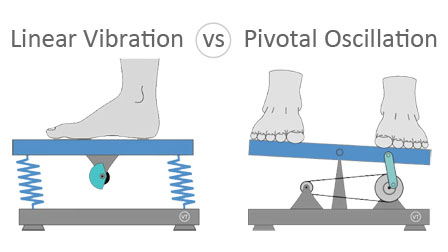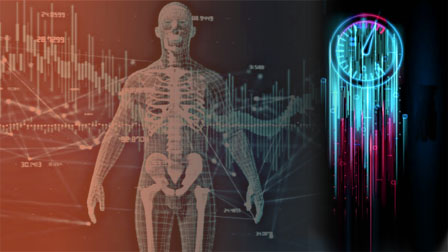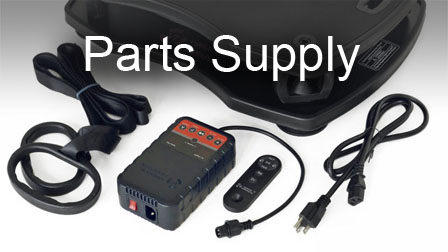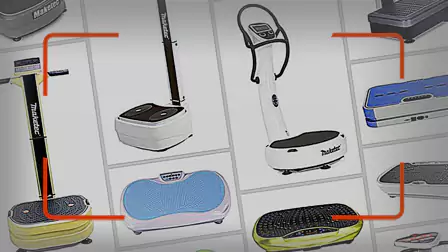Vibration Plate Buying Guide
This buying guide provides comprehensive product knowledge and insights to help you make an informed decision when selecting a vibration plate.
Page Content Index
- Four Types of Vibration Plates
- Linear Vibration Plate
- Pivotal Oscillation Plate
- 3D Vibration Plate
- 4D Vibration Plate
- Low-Intensity Vibration Plate
- Vibration Characteristics & Impact
- Designs & Features
- Vibration Plate Shakes House
- Our Recommendations
- VT Vibration Plates
- Brands & Country of Origin
Four Types of Vibration Plates
Vibration plates on the market fall into four distinct types, based on their mechanics and vibration characteristics.




Within each type, they exhibit a similar range of frequency and amplitude.
| Type | Movement | Frequency | Amplitude |
|---|---|---|---|
| Linear Vibration | Vertical | 15-40Hz | 1-3mm |
| Pivotal Oscillation | Seesaw | 5-15Hz | 5-10mm |
| 3D/4D Oscillation | Seesaw + Lateral | 5-15Hz | 5-10mm |
| Low-Intensity | Vertical | 35Hz | 0.2mm |
The movement pattern, frequency, and amplitude of vibration are key factors that determine how vibration affects our body and how our body responds to it.
Manufacturers often come up with fancy names or terms for their models, such as 3D, 4D, Tri-planar, Pulsation, Wave, PrecisionWave and others. These names or terms provide little or no clarity of the actual movement patterns. Many terms are made up for marketing hype, while some are misused or even misleading.
Inaccuracy & Bias
This buying guide involves our comments on products from other manufacturers. However, we may not always be able to obtain the most accurate information of their products.
We welcome feedback on any potential inaccuracies, biases, or overlooked points presented on this page. We will do our best to improve the informaiton quality and integrity.
Please write to us using the web form at the end of this page.
Linear Vibration Plate

Linear vibration plate utilizes an eccentric wheel and a spring mechanism to generate primarily vertical vibrations. The rotation of the eccentric wheel creates centrifugal force, which drives the vibration.
"Linear vibration" is a physics term describing a simple harmonic vibration. The term "linear" refers to a characteristic of the spring: the relationship between the displacement and the applied force is linear.

Section View of VT003F
Linear vibration plate is typically designed to vibrate at higher frequency (15-40Hz) and lower amplitude (less than 3mm).
Examples of linear vibration plates include Power Plate, VibePlate, and Vibration Therapeutic’s VT003F, VT007, and VT009.
Linear Vibration Plates Pictures
 S
S
Pivotal Oscillation Plate

Pivotal oscillation plate is a planar four-bar linkage device, which imitate a vibrational movement by transferring the motor rotation to reciprocating motion.
The movement of the device resembles a seesaw, oscillating around a fixed central pivot axis - hence "pivotal oscillation".

Section View of VT027 Pivotal Oscillation Plate
Pivotal oscillation plates are usually designed to oscillate at lower frequency (5-15Hz) and higher amplitude (8-10mm).
Manufacturers commonly label pivotal oscillation plates as vibration plates. These models dominate vibration plate listed on Amazon market place, heavily redundant in its category.
Pivotal Oscillation Plates Pictures

3D Vibration Plate

A 3D vibration plate consists of two planar four-bar linkage devices: one oscillates in a seesaw movement; the other oscillates in a lateral (side-to-side) movement. Each device is driven by a separate motor, separately controlled.
Two pivotal oscillation movements combined to form a "3D" movement.

Seesaw

Lateral

3D
Although called a "3D", the vibraion plate actually generates a complex 2-Dimensional movement.

Section View of a Jintuo 3D Vibration Plate
Just like pivotal oscillation plates, 3D vibration plates are designed to oscillate at low frequency (5-15Hz) and high amplitude (8-10mm).
3D vibration plates are created as a marketing gimmick. There is no logical basis to suggest that a more complex movement pattern is more beneficial than a simple one. It may actually be the opposite.
The side-to-side lateral oscillation of a 3D model does not engage muscle work and can instead adversely stress the knee joints.
3D Vibration Plates Pictures

4D Vibration Plate

A 4D vibration plates is made up from a 3D vibration plate by simply attaching a small eccentric wheel beneath the upper platform of a 3D vibration plate.
Therefore a 4D model has two four-bar devices plus one eccentric wheel device, each independently controlled by a separate motor, so 3 motors.

3D

Wheel

4D
Although called a "4D" vibration plate, it produces a complex 2-Dimensional movement.
This  is a pseudo add‑on device.
is a pseudo add‑on device.
The eccentric wheel in this "bump-up" 4D vibration plate is very small. Critically there is not a spring mechanism to allow any significant displacement to be delivered from its small centrifugal force. As a result, this small eccentric wheel produces only a minor tremor on the surface, basically useless, except for adding some noise.
Manufacturers have this add-on eccentric wheel to run at a frequency up to 40Hz. Therefore, even though the factual movements produced by the two four-bar devices are in frequency range of 5 - 15Hz, the manufacturer can claim that the 4D vibration plate offers a combined frequency range of 5 - 40Hz, solely because they attach a useless 40Hz eccentric wheel.
Manufacturers of 4D vibration plate literally turned an eccentric wheel to a "5th wheel", probably inspired by some American dating reality show.
In short, a 4D vibration plate is essentially a 3D vibration plate adding a very small eccentric wheel device which produces a negligible amplitude.
However, with this pseudo add-on, the manufacturer can claim their 4D vibration plate has a frequency range up to 40Hz.
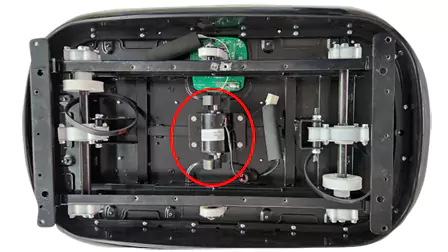
Flip open LifePro Rumblex 4D model,
a small eccentric wheel attached beneath
Manufacturers created such a "4D" vibration plate so that they can boast its complex 3-motor movements and a "bump-up" 40Hz vibration frequency.
The side-to-side lateral oscillation of a 4D vibration plate does not engage muscle work and can instead harms the knee joints.
4D Vibration Plates Pictures
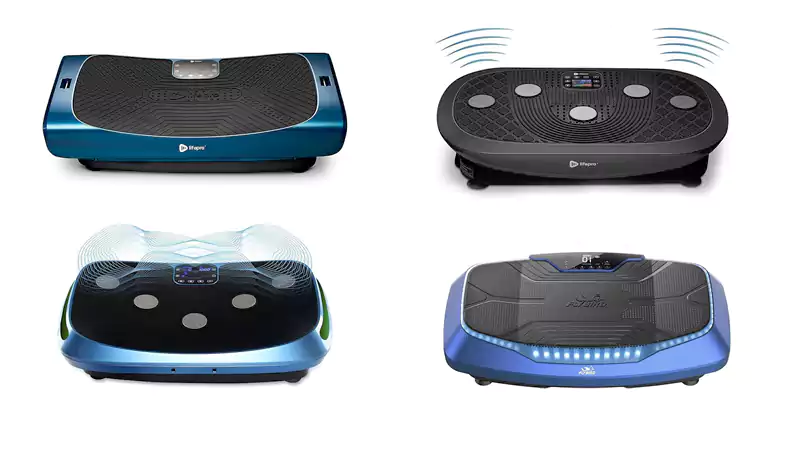
Low-Intensity Vibration

Low-intensity vibration plates form a special category, as they are so referred by two manufacturers — Juvent and Marodyne. These plates utilize either a solenoid or a piezoelectric actuator, not requiring an electric motor, to produce their high-frequency vertical oscillations.
Although not disclosed by the manufacturers, vibration plate models designed by Marodyne and Juvent most likely use either solenoid or piezoelectric actuators.
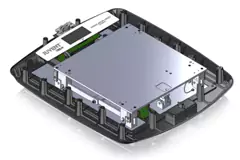
Inside Juvent Plate
Their extremely low amplitude is comparable to the thickness of a sheet of printer paper.
The claimed purpose of both Juvent and Marodyne is for osteoporosis treatment. These two brands are influential among individuals seeking vibration plate to treat osteoporosis. Both brands advocate for vibration plate with extremely low amplitude and around 30Hz frequency being beneficial for bone growth.
Juvent & Marodyne Vibration Plate Models
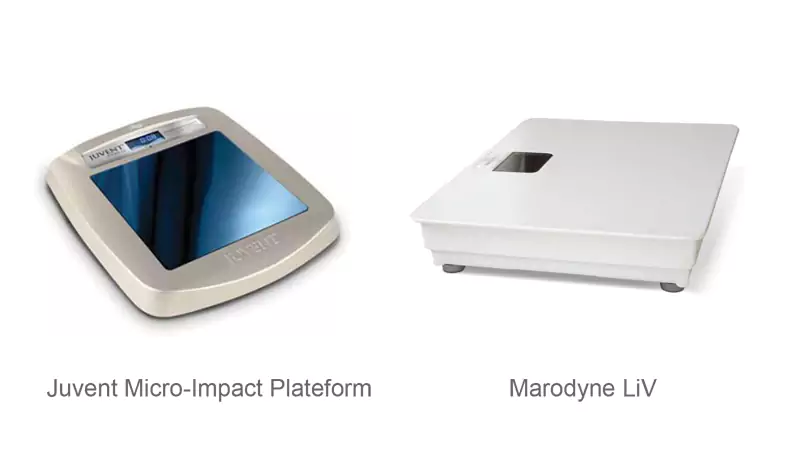
Thanks for reading this far! Let's take a break...

So far we have reviewed all four types of vibration plates. Hope you like the animations I made. Take a break before we dive into the technicals.
Relax your neck muscles with this isometric neck exercise.
Place both hands on the back of your head and push your head backward while using your hands to provide resistance.
This exercise helps relieve tension in the neck muscles and improves posture.
Muscle contraction is the remedy!
Vibration Characteristics & Their Influence on Human Body
Movement patterns, frequency, and amplitude are the most critical factors to consider when selecting a vibration plate. These characteristics decide the intensity of the vibration, how the vibration affects the body, and how the body responds to and interacts with the mechanical stimulation.
Movement Patterns
Linear vibration and pivotal oscillation are the two primary movement patterns to consider when selecting a vibration plate.
Side-to-side lateral oscillation available in 3D and 4D vibration plates does not provide health benefit. Such a movement does not engage muscle work, but on the other hand may pose a risk of harm to knee joints.
For the extreme low amplitude solenoid or piezoelectric oscillation by Juvent and Marodyne, we will have a separate page to discuss.
Here, we focus solely on examining the vibration characteristics of simple linear vibration and pivotal oscillation.
Linear Vibration

Linear vibration is mainly a vertical movement plus a minor forth-n-back horizontal movement.
Vertical movement is the essential vibration intervention for our body because it works right against gravity, maximizing the impact of vibration acceleration on the musculoskeletal system. Human body is inherently designed to withstand and overcome gravity.
Vertical vibration can travel to the upper body and head. Some people can get nausea or dizziness when their stomach or brain is vibrated.
How to avoid nausea and dizziness
Nausea and dizziness can be prevented by minimizing vibrations from reaching the upper body. On a vibration plate, users can bend their knees (squat) or lift their heels (calf-raise or tiptoe) to control the amount of vibration being transferred up, and thereby preventing these adverse effects.
In fact, squat, calf-raise and tiptoe are among the most effective exercise poses for utilizing vertical vibration in lower limb muscle training.
Pivotal Oscillation
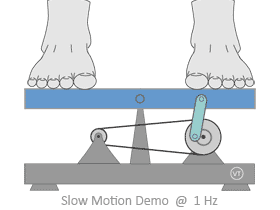
Pivotal oscillation is a seesaw movement. It moves the two feet up and down in alternation, as well as tilts the body left and right. This tilting action forms another pivot point at the waist, corresponding the pivot point on the vibration plate.
On a pivotal oscillation plate, the hips move laterally, side to side, while no vertical movement is transmitted to the upper body. Pivotal oscillation usually does not cause nausea or dizziness.
Pivotal oscillation plates are typically designed to produce higher amplitudes, which cause significant side-to-side body swings. For physically weak individuals, it is advisable to use a handrail to ensure balance and stability.
Vibration Frequency
Vibration frequency refers to the number of up-and-down movements a vibration plate completes per second.
Linear vibration plates are typically designed to operate within a higher frequency range, usually between 15Hz and 40Hz.
Pivotal oscillation plates are typically designed to operate within a lower frequency range of 5Hz to 14Hz.
Different vibration frequencies affect how vibration is transmitted to the body and how the body responds to the stimulation. Click the link below for details.
Vibration Amplitude
For vibration plates, amplitude is defined as the vertical displacement of the plate during vibration.
Linear vibration plates are typically designed to deliver an amplitude of less than 3 mm. Its amplitude is subject to change when the body weight or the vibration frequency changes.
In contrast, pivotal oscillation plates are designed to deliver a higher amplitude, usually ranging from 8 to 10 mm at edges of the two sides. Their amplitude remains consistent, unaffected by body weight or vibration frequency.
Due to its seesaw movement, the amplitude at the center of pivotal oscillation plate is zero.
G-force
G-force is a key indicator of vibration intensity. While some manufacturers do not provide the G-force value for their vibration plates, it can be calculated if the frequency and amplitude are known.
Despite its name, G-force is not a force, but an acceleration rate expressed in units of G, the acceleration rate of gravity.
G-force is a useful metric for comparing the intensity of different vibration plate models.
Designs & Features
Beyond the choices of different movement patterns and parameters, there are various of design styles and features offered by different vibration plate models.
Manufacturers always try hard to find ideas to differentiate their vibration plates in the market. However, most variations are just cosmetic changes applied to generic designs.
Some manufacturers offer vibration plate models with designs that add little or no practical value, such as decorative lighting, Bluetooth speakers, warm-up top, and more.
Among the the designs and features, some are straightforward essentials, like a remote control. Beyond that, the features listed below deserve some closer examination.
Hand Straps
Hand straps have become a standard accessory included in almost all vibration plate. However, hand strapes have no practical use on a vibration plate and can cause a safety issue.
All pivotal oscillation plates on the market come with a pair of elastic hand straps. The only purpose, as demostrated, is for arm exercise. However, the vibration does not transmit to the arms because it is completely absorbed by the elastic hand straps.
On a vibratin plate, user's hands need to free up for balance, or if necessary, hold on a rigid handlebar. If more resistence is desired, holding a pair of dumbbells is a much better idea, and better suit for many exercise poses.
Handlebar
A handlebar is a helpful feature for users who need extra support for balance and stability. However, it can restrict the range of exercise poses that can be performed on the vibration plate.
Some lightweight vibration plates come with an a handlebar attachment, which may not be safe to rely on, as the machine could tip over during use.
A separate handlebar, such as a diy wall-mounted one, offers reliable stability without limiting exercise poses a user can perform.
Adjustable Frequency
Manufacturers may not disclose the frequency of their vibration plates. Instead, they use "Speed Level" as an indicator of the speed. The "Speed Level" is relative value and does not tell the actual frequency.
Adjustable frequency makes the vibration plate versatile, enabling a wide range of applications. It also allow new users to start with lower frequency like 15Hz, get used to the vibration, and gradually progress to a higher frequency of their desire, like 30Hz.
Amplitude Setting
Pivotal oscillation plates do not have an amplitude setting feature.
Some linear vibration plate models do not have amplitude setting feature, while other linear vibration plate models come with such a feature. The VT007 vibration plate, for instance, comes with a 2 amplitude settings.
Amplitude setting feature enhances the versatility of the vibration plate. For example, physically weak people can begin with low amplitude setting and, as their strength improves, they can switch to high amplitude setting.
Speed Level
Speed level is not a standard term for describing vibration. It does not tell the frequency.
However many manufacturers use speed level to indicate the speed of their vibration plates.
Each manufacturer defines speed level differently, making it impossible to compare the speed level between models.
Manufacturers often use speed level as a marketing gimmick. For example, a manufacturer may set 99 adjustable levels for a vibration plate with an adjustable frequency range of 5?C15Hz. However, for such a vibration plate, 10 adjustable frequency levels, 1Hz increments, are enough and convenient to use. Some even set 180 adjustable speed levels for a 5 - 12Hz vibration plate. So you see a 180 speed vibration plate is not necessarily faster than and 99 speed vibration plate.
Motor Power
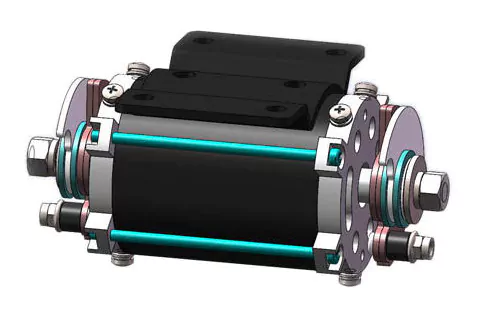
VT007 DC motor - 80W
For a linear vibration plate, a motor with 80W to 120W is adequate to support users weighing up to 300 lbs.
For a pivotal oscillation plate, a motor with 200W to 300W is sufficient for users weighing up to 300 lbs.
The required motor power also depends on the machine's design. Some manufacturers / sellers may exaggerate motor power specifications for marketing purpose.
Machine size
Choose the right size vibration plate based on how you plan to use the machine, such as the types of exercises you intend to perform on it.
Larger machines tend to provide more intensity but are typically more expensive, heavy, bulky, and may exert too much impact on the house.
Smaller machines, on the other hand, may not support a wide range of exercise poses and are generally less intensive.
Bluetooth speaker feature, important!
You definitely want this feature if you feel like to rock out to music played from a janky wacky speaker.
Even more fun is that each time when you turn on your vibration plate, you will hear from below a famous lady-voice prompt: "Your bluetooth dewise is ready to pair."
This
Warm-up top
Maybe useful if you live in Minnesnowta, have a broken window in your house and have to use a vibration plate in the winter.
Vibration Plate Shakes House

Using a vibration plate at home can pose a risk of structural damage to your house due to the mechanical effects of vibration.
Click the link below to learn about the potential damage, a comparison with washing machines, an analysis of different types of vibration plates, and the steps you can take to minimize potential adverse effects.
Mobile home and the upper floor of a wood-frame house are not suitable place to use a vibration plate.
Our Recommendations
We do not recommend 3D or 4D vibration plates, as there is no scientific basis that these complex motion patterns would offer additional advantages. These products are created for marketing hype. It is important to be aware that the lateral (side-to-side) movement can be harmful to the knee joints.
Neither do we recommend low-intensity vibration plates, such as the Juvent and Marodyne LiV, because their extremely low amplitude does not provide a meaningful treatment intervention. Their purported effects on molecular process, such as influencing stem cell differentiation, remain beyond the scope of established scientific evidence and approval.
Our general recommendation for anyone interested in exploring vibration therapy is either using a simple pivotal oscillation plate or a linear vibration plate. The shared user experiences of these two types of machines are abundant on the internet. They have been proved safe to use.
Check the link below for a close look of the differences between linear vibration plate and pivotal oscillation plate.
Please note that no scientifically validated exercise or treatment protocols, recommendations, or effectiveness have been established regarding movement patterns, frequency, amplitude, exercise postures, or exercise routines.
At Vibration Therapeutic, we provide detailed product information and shares our own science-based studies to help you explore the potential benefits of vibration therapy.
We encourage you to do your research and consult with healthcare professionals to determine if vibration therapy is right for you.
While sellers and manufactures may take pseudo approaches to promote their vibration plates, vibration intervention and its influence on human body are facts and should be scientifically examined. Vibration intervention is unique, and may achieve the results that are not available from mainstream medicine. Positive evidences are abundant, with many life-changing success stories.
Make an informed decision, choose the right vibration plate, and start to unlock the potential of vibration therapy.
Introducing VT Vibration Plates
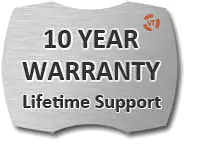
Vibration Therapeutic® offers both linear vibration models (VT007 and VT009) and a pivotal oscillation model (VT027). We concentrate on only these two models and continuously improve their quality and performance.
Both models come with our 90 day free return policy (US only) and a 10 year warranty.
VT007 Linear Vibration Plate
- Robust, reliable, and durable
- Industrial style for easy maintenance or service
- Probably the most reasonably designed home-use vibration plate ever made
- 4.9 star rating with insightful and stellar reviews on Amazon
- More ...
VT027 Pivotal Oscillation Plate
- Robust, reliable, and durable
- Patent twin-coupler design (all aluminum alloy), compared to nylon-sheet metal single-coupler design of all other pivotal oscillation models in the market.
- Shortest in height among all pivotal oscillation plate model with the same platform size, due to the twin-coupler design.
- 4.8 star rating with stellar reviews on Amazon
- More ...
Brands & Country of Origin
Models Made in China
All vibration plate models currently (as of 2024) listed on Amazon are manufactured by Chinese OEM factories and sold under many brands and off-brands.
Most of these models are white-label products redundantly derived from just a handful of generic OEM designs. Below list includes the most popular white-label brands offered via Amazon.
| Brand | Country of Origin | Products |
| LifePro | China | Pivotal oscillation plate, 3D/4D |
| Bluefin | China | Pivotal oscillation plate, 3D/4D |
| AVX | China | Pivotal oscillation plate, 3D/4D |
| Eilison | China | Pivotal oscillation plate, 3D/4D |
| Confidence | China | Pivotal oscillation plate |
Many small sellers on Amazon don't identify themselves, or do not have much web presence except for their product listings on Amazon.
Only a few brands are proprietary designs, which include Power Plate, Hypervibe and our Vibration Therapeutic.
| Brand | Country of Origin | Products |
| Power Plate | China | Linear vibration plates |
| Hypervibe | China | Pivotal oscillation plates |
| Vibration Therapeutic | China | Linear vibration plates and pivotal oscillation plates |
Models Made in USA and Germany
Other than manufacturers in China, there are only four manufacturers (brands) from the US and Germany making vibration plates of their own properietary designs.
| Brand | Country of Origin | Products |
| VibePlate | USA | Linear vibration plates |
| Juvent | USA | Low-intensity vibration plates |
| Galileo | Germany | Hi frequency pivotal oscillation plates |
| Marodyne | Germany | Low-intensity vibration plates |
Beyond the brands mentioned above, there would not be other ones with significant market presence or availability.
Jay Tang, M.S. Mechanical Engineering
Updated in Sept, 2025
